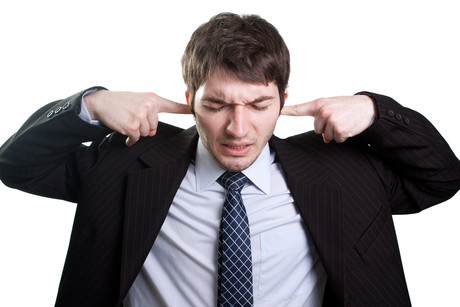Noisy offices could be putting employees at risk

Hearing loss is not the only detrimental side effect of a noisy workplace.
Employers should be aware that even a moderately noisy workplace can impact the wellbeing of their staff, according to experts.
“While excessive noise can cause hearing loss, moderate levels which may not be damaging to hearing can increase stress, decrease motivation and therefore reduce workplace productivity,” said Associate Professor Catherine McMahon, head of Audiology at Macquarie University’s Australian Hearing Hub.
“Stress increases cortisol levels, which can affect our weight, increase the risk of cardiovascular disease, depression and lead to lower life expectancy. Noise can also reduce our ability to sleep, and due to the need for increased attention to what we are doing — listening to someone speak, reading or writing — we are generally more fatigued by the end of the day. Of course, this can also cause increased effort when thinking, frustration and anxiety.”
While excessive noise is a leading cause of hearing loss, with a 2010 Access Economics Report attributing noise as the reason behind 37% of hearing loss cases in Australia, the impact of moderate noise levels on wellbeing and physical health can also be quite severe.
The researchers are using Hearing Awareness Week this August to encourage employers to make working spaces comfortable for their staff.
In particular, workplace areas such as open plan offices may be innovative in terms of design, but they also need to be acoustically well considered.
“Noise is a subjective parameter, therefore we need to assess how an individual reacts to sound and determine its effects on distractibility, stress and productivity. For example, it’s important to remember that speech is time varying and changes in level and informational content. Therefore, speech from an adjacent cubical can be considered annoying if it is distracting others from working, which is not simply a matter of the level of an individual’s voice,” said McMahon.
In addition to companies and employers taking into account office acoustic design, McMahon also suggests the use of noise-cancelling headphones in noisy areas.
“Noise-cancelling headphones may help to some extent in reducing the impact of noise on a worker, particularly if the office can’t be altered to reduce sound. However, it should be noted that these types of headphones are designed to reduce the levels of noise, which has a different spectral quality than speech.”
However, one of the biggest tips that McMahon offers workplaces is to support their employees in taking breaks in order to reduce the impact of a noisy workplace.
“Noise and stress are cumulative — everyone needs a break from noise. So taking a lunch break or going for a walk during the day is a great strategy and is good for your physical and mental health,” she said.
Hearing Awareness Week is taking place from 20–26 August 2017.
Engaging the workforce with safety wearables: key considerations
The success of safety wearables lies not just in their objective data, but in how they engage...
What are the key safety tech trends for 2024?
Promoting and protecting worker safety is a critical objective for Australian businesses.
Heat stress devices trialled on workers
A new approach designed to protect outdoor workers from the dangerous effects of heat is being...










